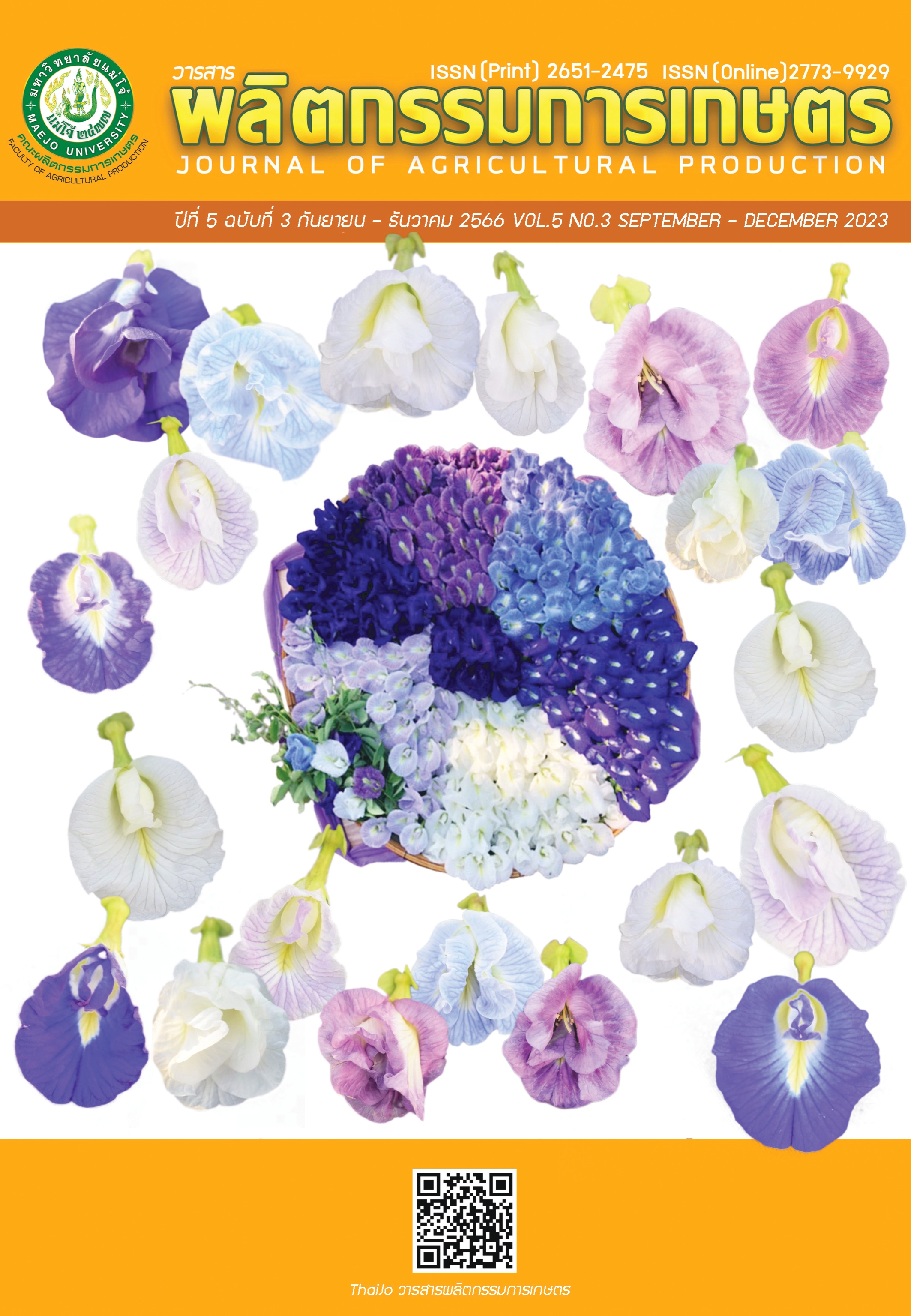Time of Flowering and Quality of Flowers in Thai Commercial Chrysanthemums as Affected by Photoperiod and high night temperature
Main Article Content
บทคัดย่อ
Chrysanthemum is a facultative short-day plant with the tendency to flower late when night temperatures are high. Therefore, year-round cultivation of high-quality chrysanthemums in Thailand is not desirable. Some day-neutral chrysanthemum cultivars are insensitive to heat-delay phenotype. Consequently, the discovery of these key characteristics through the planting of many cultivars can be the key to enhancing the breeding programme. Eleven Thai chrysanthemum cultivars were selected and planted under various conditions, including an average day length of 11.47 hours (SD), long days with incandescent light night break (LD1), and long days with incandescent light night break with a night temperature of 30.23 °C (LD2). The number of leaves on the main stem at flowering, the length of the main stem at flowering, the diameter of the terminal flower, the number of LD leaves, the ratio of flowering to nonflowering plants, and the thermostability of cell membrane were measured and analysed. By removing the light integral factor, all cultivars in this study were able to flower in both SD and LD conditions. The effects of different photoperiods and night temperatures on flowering time and floral quality varied amongst cultivars. Each cultivar, especially ‘Kaewglom’, exhibited a unique pattern of sensitivity, which benefits the selection for a new breeding programme to create new dayneutral and heat-tolerant cultivars more suitable for the cut flower market.
Article Details

อนุญาตภายใต้เงื่อนไข Creative Commons Attribution-NonCommercial-NoDerivatives 4.0 International License.
เอกสารอ้างอิง
Adams, S., M. Munir, V. Valdes, F. Langton and S. Jackson. 2003. Using flowering times and leaf numbers to model the phases of photoperiod
sensitivity in Antirrhinum majus L. Annals of Botany 92(5): 689-696.
Anderson, N.O. 2007. Chrysanthemum. pp. 389- 437. In: Flower breeding and genetics. Springer Dordrecht. Berlin.
Anderson, N.O., M.K. Won and D.C. Kim. 2016. Garden chrysanthemum cell Membrane thermostability and flowering heat delay differences among US and south korean germplasm. HortScience 51(3): 216-226.
Assaad, H., L. Zhou, R. Carroll and G. Wu. 2014. Rapid publication-ready MS-word tables for One-Way ANOVA. Springerplus 3: 474.
Belay, M.H., H.M. Beshir, M.T. Terfa and A.G. Roro. 2021. Control of growth and flowering ofchrysanthemum (Dendranthema x grandiflorum Kitam.) using day length extension and Red Light Night Break. Ornamental Horticulture 27: 365-373.
Cho, A.R. and Y.J. Kim. 2021. Night temperature determines flowering time and quality of Chrysanthemum morifolium during a high day temperature. Journal of Horticultural Sciences. 96(2): 239-248.
Chomchalow, N. 2004. Flower forcing for cut flower production with special reference to Thailand. ABAC Journal 7: 137-144.
Cockshull, K.E. 2019. Chrysanthemum morifolium. pp. 238-257. In: CRC handbook of flowering. CRC Press.
Komkris, S. 1964. Chrysanthemum varieties trial. Kasetsart Journal 4(1-2): 18-22.
Krasaechai, A. and K. Senawong. 2003. Chrysanthemum morifolium varietal
improvement. Proceedings of the Royal Project Foundation annual report 2003. Chiang Mai, Thailand. pp. 17-37.
Mekapogu, M., O.K. Kwon, H.Y. Song and J.A. Jung. 2022. Towards the improvement of ornamental attributes in chrysanthemum: recent progress in biotechnological advances. International Journal of Molecular Sciences 23(20): 12284.
Mizoguchi, T., K. Niinuma and R. Yoshida. 2007. Day-neutral response of photoperiodic flowering in tomatoes: possible implications based on recent molecular genetics of Arabidopsis and rice. Plant Biotechnology Journal 24(1): 83-86.
Nakano, Y., Y. Higuchi, K. Sumitomo, A. Oda, T. Hisamatsu and Naro. 2015. Delay of flowering by high temperature in chrysanthemum: heat-sensitive time-of-day and heat effects on CsFTL3 and CsAFT gene expression.Journal of Horticultural Science and Biotechnology 90(2): 143-149.
Nakano, Y., T. Takase, K. Sumitomo, S. Suzuki, K. Tsuda-Kawamura and T. Hisamatsu. 2020. Delay of flowering at high temperature in chrysanthemum: duration of darkness and transitions in lighting determine daily peak heat sensitivity. The Horticulture Journal 89(5): 602-608
Nissim-Levi, A., M. Kitron, Y. Nishri, R. Ovadia, I. Forer and M. Oren-Shamir. 2019. Effects of blue and red LED lights on growth and flowering of Chrysanthemum morifolium. Scientia Horticulturae 254: 77-83.
Nothnagl, M., A. Kosiba and R.U. Larsen. 2004. Predicting the effect of irradiance and temperature on the flower diameter of greenhouse grown Chrysanthemum. Scientia Horticulturae 99(3-4): 319-329.
Palai, S., G. Madhuri, M. Nath and S. Bhuyan. 2018. Effect of planting dates and photoperiod on growth and flowering of chrysanthemum (Chrysanthemum morifolium Ramat) cv. yellow Reagan. Pharma Innovation Journal 7(5): 106.
Park, Y.G. and B.R. Jeong. 2020. How supplementary or night-interrupting low-intensity blue light affects the flower induction inchrysanthemum, a qualitative short-day plant. Plants 9(12): 1694.
SharathKumar, M., E. Heuvelink, L.F. Marcelis and W. Van Ieperen. 2021. Floral induction in the short-day plant chrysanthemum under blue and red extended long-days. Frontiers in Plant Science 11: 610041.
Sumitomo, K., A. Yamagata, A. Oda and T. Hisamatsu. 2014. Identification of high longday leaf number cultivars and prevention of premature budding by cold pre-treatment for fine control of flowering in summer-toautumn- flowering chrysanthemum (Chrysanthemum morifolium Ramat.). Journal of Horticultural Science and Biotechnology 89(6): 647-654.
Time and Date AS. 2022. Sun Graph for Chiang Mai. Available: https://www.timeanddate.com/ sun/thailand/chiang-mai?month=3&year=2022 (March 31, 2022).
Yeh, D., and H. Lin. 2003. Thermostability of cell membranes as a measure of heat tolerance and relationship to flowering delay in chrysanthemum. Journal of the American Society for Horticultural Science 128(5): 656- 660.


